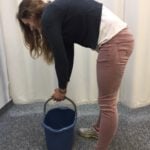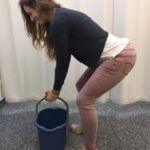 Germaphobes, cleaning zealots, neat freaks, and those with diagnosed or undiagnosed obsessive compulsive disorder (OCD), this column is for you! If you would rather clean your bathroom floor than go for a walk on a beautiful sunny day, please read on. If you use a toothbrush on tile grout on a regular basis and take pride in the sparkle of your toilet bowl than beware… studies show that performing these tasks with too much vigor and passion might lead to back, neck, and shoulder and wrist pain.
Germaphobes, cleaning zealots, neat freaks, and those with diagnosed or undiagnosed obsessive compulsive disorder (OCD), this column is for you! If you would rather clean your bathroom floor than go for a walk on a beautiful sunny day, please read on. If you use a toothbrush on tile grout on a regular basis and take pride in the sparkle of your toilet bowl than beware… studies show that performing these tasks with too much vigor and passion might lead to back, neck, and shoulder and wrist pain.
For some, and you know who you are, (I am related to a few) spring cleaning can be a particularly exciting sporting event. It is almost an exorcism to rid a home of all its evil spirits; smudges, dust, dirt, germs, and odors. Every April curtains come off the windows to be washed and carpets rolled up, remove and cleaned. The surfaces under the curtains and carpets are sterilized with cleaning detergents, disinfectants and chemicals that would make sterile technique in most hospital operating rooms seem to be inadequate. And, that doesn’t include the heavy work: moving furniture, bedding, including mattresses and box springs.
As a physical therapist and survivor of childhood exposure to copious amounts of cleaning chemicals, I have come to learn that there are healthy and safe options for spring cleaning your home. Of course, the most obvious solution is to hire professional help if you could afford it. The other practical solutions are below:
10 Health Tips for Spring Cleaning:
- Have a Plan - Take your time
- It doesn’t have to be done in one day or one weekend!
- Make a list, follow a schedule and do it over the course of 3-4 weeks.
- Do Not Move Heavy Furniture or Appliances by yourself
- Get Help –
- Use Sliders – to move heavy items like furniture
- Be Cautious on Ladders and Stools
- Falls are a leading cause of injury mortality in the US and 43% of fatal falls have involved a ladder, according to the Centers for Disease Control (CDC).
- Avoid Reaching or stepping on the top step
- Open and lock the ladder properly instead of leaning it against a wall
- Use Proper Ergonomics
- Lift Properly – back straight, knees bent (PHOTO A & B)
- Work at Eye Level – don’t work overhead for extended periods of time (PHOTO C & D) Working overhead extends the neck and back and can lead to compression of the spine. This can cause pain, muscle spasms, headaches and pinched nerves which radiate symptoms into the arms and legs. Also, over extending and reaching with the shoulder, such as when cleaning windows, can lead to shoulder pain and stiffness from tendonitis or bursitis.
- Wear a support if needed: knee or back brace, tennis elbow strap, arch supports
- Avoid Prolonged Squatting – instead, kneel on a kneeling pad or wear knee pads
- Use Caution Walking on Wet Surfaces
- Use Caution Working Around Water and Electricity
- Use Caution When Working with Household Cleaning Chemicals – provide adequate air circulation
- Wear a Mask – when using cleaning chemicals or around dust, mold etc
- Limit the Amount of Weight or Items You Carry – especially on the stairs
- Take Breaks
- Hydrate, Eat, and Rest
- Stretch – neck, back, shoulders (PHOTO E, F, G)
-

-
Photo A - Poor Lifting
-

-
Photo B - Proper Lifting
-

-
Photo C - Poor Overhead Reach
-

-
Photo D - Proper Eye-level Work on stool
-

-
Photo E - Chin Tuck Stretch
-

-
Photo F - Shoulder Blade Stretch
-

-
Photo G - Lower Back Stretch
10 Safety Tips for Spring Cleaning:
- Replace or Clean Filters for air and heat units
- Clean out Medicine Cabinet
- Get rid of unused and expired meds properly
- Call your local pharmacist for details
- Clean Attic, Garage, Cabinets and Basement of Dangerous Chemicals or toxic trash
- Old paint cans, paint thinner, soiled rags, brushes etc
- Contact your local government agency or recycling center for details
- Remove mold and fungus from bathroom and laundry room
- Replace Batteries in Smoke, Fire and Carbon Monoxide Detectors
- Clean the Chimney – call a professional to protect you from carbon monoxide exposure
Sources: National Center for Injury Prevention and Control at the CDC, www.medicinenet.comwww.household-management-101
Model: Sarah Singer, PTA
Read Dr. Mackarey’s Health & Exercise Forum – Every Monday.
This article is not intended as a substitute for medical treatment. If you have questions related to your medical condition, please contact your family physician. For further inquires related to this topic email: drpmackarey@msn.com
Paul J. Mackarey PT, DHSc, OCS is a Doctor in Health Sciences specializing in orthopaedic and sports physical therapy. Dr. Mackarey is in private practice and is an associate professor of clinical medicine at Geisinger Commonwealth School of Medicine.
 Germaphobes, cleaning zealots, neat freaks, and those with diagnosed or undiagnosed obsessive compulsive disorder (OCD), this column is for you! If you would rather clean your bathroom floor than go for a walk on a beautiful sunny day, please read on. If you use a toothbrush on tile grout on a regular basis and take pride in the sparkle of your toilet bowl than beware… studies show that performing these tasks with too much vigor and passion might lead to back, neck, and shoulder and wrist pain.
Germaphobes, cleaning zealots, neat freaks, and those with diagnosed or undiagnosed obsessive compulsive disorder (OCD), this column is for you! If you would rather clean your bathroom floor than go for a walk on a beautiful sunny day, please read on. If you use a toothbrush on tile grout on a regular basis and take pride in the sparkle of your toilet bowl than beware… studies show that performing these tasks with too much vigor and passion might lead to back, neck, and shoulder and wrist pain.